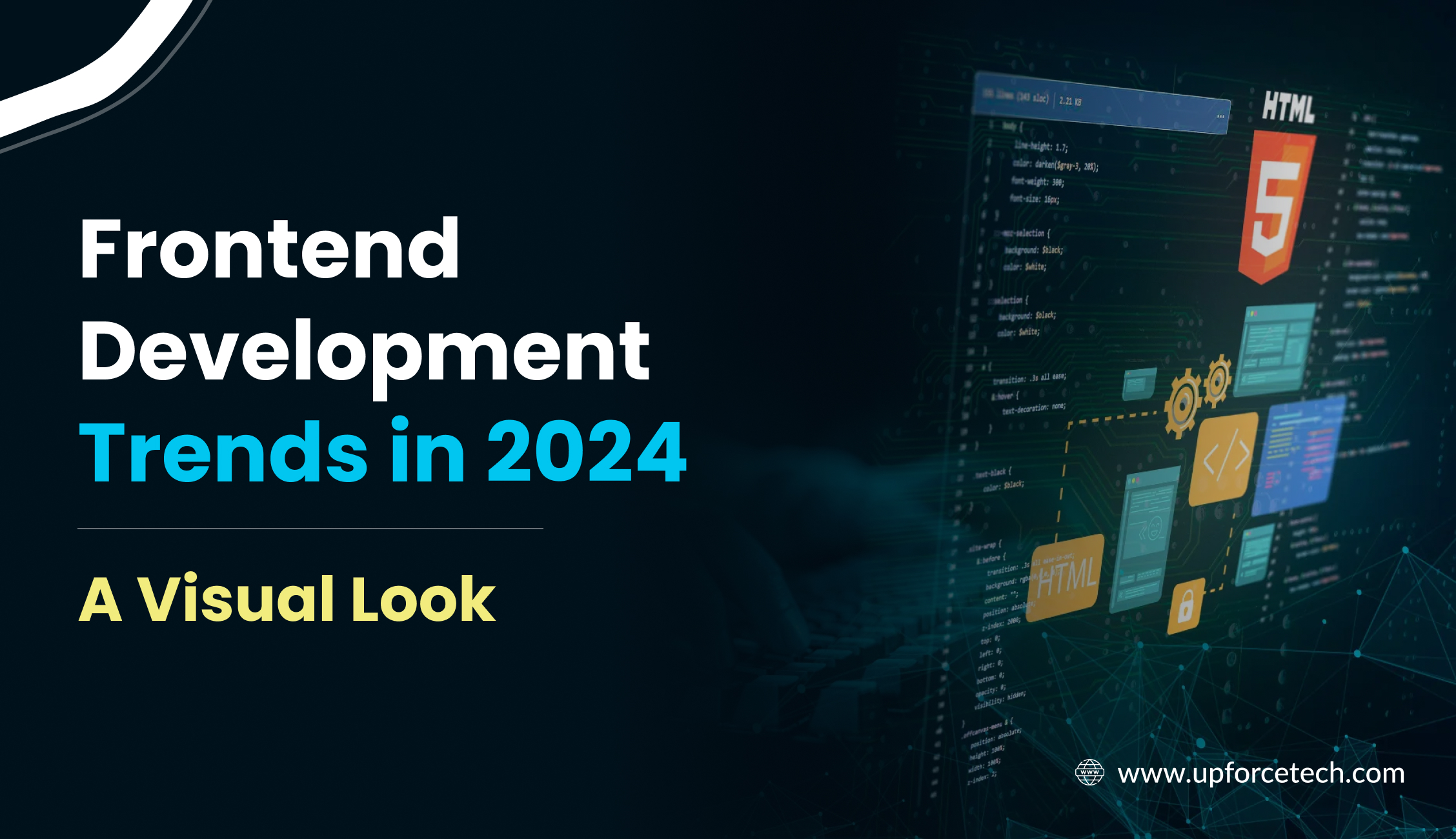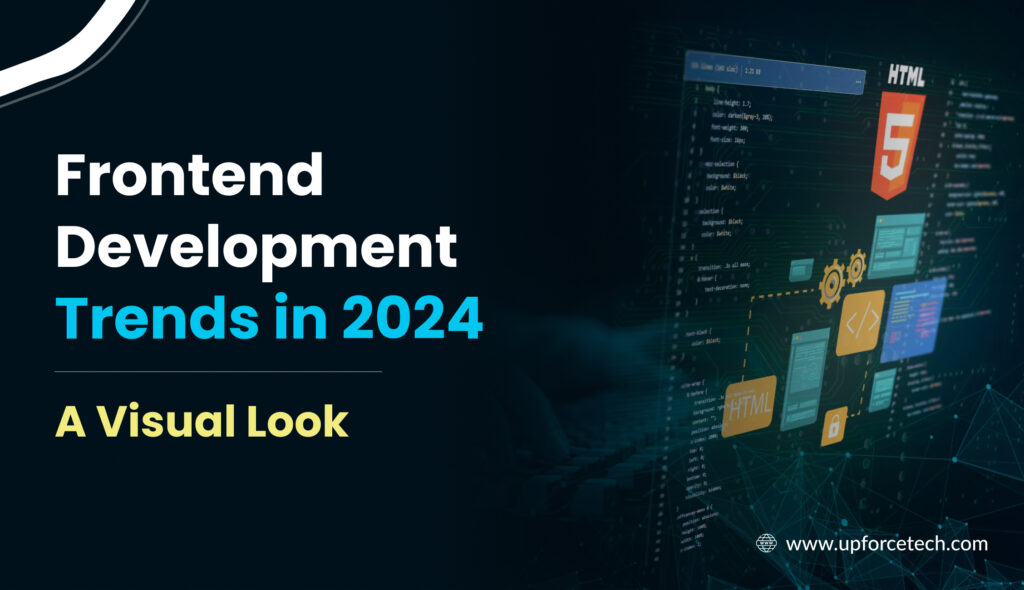Front-end Development Trend in 2024
Table of Contents

As we move further into 2024, front-end development continues to evolve at a rapid pace. With new technologies, frameworks, and design paradigms emerging, developers and businesses alike must stay informed about the latest trends to remain competitive. In this comprehensive guide, we’ll explore the key front-end development trends expected to dominate in 2024, and how these trends will shape the future of web and app development.
Understanding Front-End Development
Before diving into the trends, let’s clarify what front-end development is. It’s the process of creating the part of a website or app that users see and interact with. This includes the design, layout, and behavior of the website or app.
Front-end developers use technologies like HTML (to structure content), CSS (to style content), and JavaScript (to make things interactive) to build amazing digital experiences.
Top Front-End Development Trends in 2024
1. Progressive Web Apps (PWAs)
PWAs are websites that work like apps. They offer a fast, reliable, and engaging experience to users. They can be installed on your phone like an app, work offline, and send notifications. Think of them as the best of both worlds: the speed and reach of a website, with the features of an app.
- Benefits: Improved user experience, better performance, offline functionality, and increased engagement.
- Examples: Twitter, Pinterest, and Instagram have implemented PWA features.
2. Artificial Intelligence (AI) and Machine Learning (ML)
AI and ML are no longer just for complex algorithms. They’re now making their way into front-end development. From smart chatbots to personalized recommendations, AI and ML are enhancing user experiences.
- Benefits: Improved personalization, better user interactions, and automated tasks.
- Examples: Chatbots on e-commerce websites, and recommendation systems on streaming platforms.
3. Serverless Architecture
Serverless architecture is a cloud computing execution model where the cloud provider dynamically manages the allocation of machine resources. In front-end development, this means you can focus on writing code without worrying about managing servers.
- Benefits: Reduced costs, faster development, and increased scalability.
- Examples: Using serverless functions for handling user events or data processing.
4. Jamstack
Jamstack is a modern architecture for building fast, secure, and pre-rendered websites. It combines pre-built components, APIs, and Git for deployment. This approach leads to better performance and security.
- Benefits: Improved performance, enhanced security, and faster development.
- Examples: Static websites with dynamic content powered by APIs.
5. Single Page Applications (SPAs)
SPAs are websites that load a single HTML page and dynamically update content as users interact with it. This creates a more app-like experience.
- Benefits: Improved user experience, faster interactions, and better performance.
- Examples: Most modern web applications, like Gmail and Facebook.
6. JavaScript Frameworks and Libraries
JavaScript frameworks and libraries continue to evolve. React, Angular, and Vue.js remain popular choices, but new and emerging options are gaining traction.
- Benefits: Faster development, better code organization, and reusable components.
- Examples: React for building user interfaces, Angular for large-scale applications, and Vue.js for flexibility.
7. Accessibility
Making websites accessible to everyone is crucial. This includes people with disabilities, as well as those using different devices or network conditions.
- Benefits: Reaching a wider audience, improving user experience, and complying with legal requirements.
- Examples: Using semantic HTML, providing alternative text for images, and ensuring keyboard navigation.
8. Responsive Design and Mobile-First Approach
With the increasing number of mobile users, responsive design is essential. It ensures websites look good and function well on different screen sizes. A mobile-first approach means designing for smaller screens first and then scaling up.
- Benefits: Better user experience on different devices, increased reach, and improved SEO.
- Examples: Websites that adapt to different screen sizes and orientations.
9. Performance Optimization
Fast websites are crucial for user satisfaction. Techniques like code minification, image optimization, and lazy loading can significantly improve performance.
- Benefits: Improved user experience, better search engine rankings, and increased conversions.
- Examples: Using content delivery networks (CDNs), compressing images, and deferring non-critical resources.
10. Cybersecurity
Protecting user data is paramount. Front-end developers need to be aware of common vulnerabilities and implement security best practices.
- Benefits: Protecting user data, maintaining trust, and preventing data breaches.
- Examples: Using HTTPS, input validation, and preventing cross-site scripting (XSS).
Deeper Dive into Front-End Development Trends
The Rise of Component Libraries and Design Systems
In the pursuit of efficiency and consistency, component libraries and design systems have gained significant traction.
- Component Libraries: These are collections of pre-built UI components (buttons, inputs, cards, etc.) that can be reused across different projects. They accelerate development, ensure design consistency, and improve code maintainability. Popular examples include Material UI, Ant Design, and Bootstrap.
- Design Systems: A comprehensive guide to how a product looks, feels, and works. They encompass not just components but also typography, color palettes, spacing, and interaction patterns. Design systems promote brand consistency and streamline collaboration between designers and developers.
The Importance of Accessibility
Making websites accessible to everyone is no longer an option but a necessity. It’s about creating inclusive digital experiences.
- Key Considerations:
- Semantic HTML: Using HTML elements for their intended purpose.
- ARIA Attributes: Providing additional information for assistive technologies.
- Color Contrast: Ensuring sufficient contrast between text and background.
- Keyboard Navigation: Enabling users to navigate the website using the keyboard.
- Alternative Text: Providing descriptive text for images.
The Impact of WebAssembly (WASM)
WebAssembly (WASM) is a binary format for efficient execution of code in web browsers. While primarily used for performance-critical applications, it’s gradually expanding its reach.
- Benefits:
- High performance: Can run code at near-native speeds.
- Portability: Can be used across different platforms.
- Security: Runs in a sandboxed environment.
The Future of JavaScript: TypeScript
TypeScript, a superset of JavaScript, is gaining popularity due to its added features like static typing, improved code readability, and better tooling support.
- Benefits:
- Early error detection: Helps catch potential issues during development.
- Improved code maintainability: Easier to understand and modify code.
- Better tooling support: IDEs provide advanced features like code completion and refactoring.
The Growing Significance of Developer Experience (DX)
A positive developer experience is crucial for productivity and job satisfaction. It encompasses factors like tooling, workflow, and collaboration.
- Key Components:
- Efficient development environment: Fast build times, hot reloading, and debugging tools.
- Strong community and support: Access to resources and help.
- Well-structured codebase: Clear and maintainable code.
- Automation: Streamlining repetitive tasks.
The Role of Cloud-Based Development
Cloud platforms offer a scalable and cost-effective infrastructure for front-end development. They provide services like hosting, databases, and content delivery networks (CDNs).
- Benefits:
- Scalability: Easily handle increasing traffic and workloads.
- Cost-efficiency: Pay only for the resources you use.
- Global reach: Deliver content faster to users around the world.
Emerging Trends to Watch
- Motion Design: Creating engaging user interfaces through thoughtful use of animation.
- Micro-interactions: Adding small details to enhance user experience.
- Voice User Interfaces (VUIs): Developing conversational interfaces for voice assistants.
- Augmented Reality (AR) and Virtual Reality (VR): Creating immersive experiences.
- Blockchain: Securing and verifying data on decentralized networks.
The Impact of Front-End Trends on Different Industries
E-commerce
E-commerce heavily relies on a seamless user experience. Front-end development trends are transforming the online shopping landscape.
- Personalized Experiences: Leveraging AI and ML to offer tailored product recommendations and content.
- Accelerated Checkout: Implementing frictionless checkout processes using PWAs and serverless functions.
- Immersive Shopping: Using AR and VR to create virtual try-on experiences.
- Mobile Optimization: Ensuring a responsive and optimized shopping experience across devices.
Healthcare
The healthcare industry is increasingly adopting digital solutions. Front-end development plays a vital role in creating user-friendly healthcare applications.
- Telemedicine: Building secure and reliable platforms for virtual consultations.
- Patient Portals: Developing intuitive interfaces for patients to access medical records and schedule appointments.
- Wearable Integration: Integrating data from wearable devices for personalized healthcare.
- Accessibility: Ensuring compliance with accessibility standards for patients with disabilities.
Finance
The financial sector is undergoing a digital transformation, with front-end development at the forefront.
- Mobile Banking: Creating secure and user-friendly mobile banking apps.
- Financial Dashboards: Developing interactive dashboards for personalized financial insights.
- Fraud Prevention: Implementing robust security measures to protect user data.
- Accessibility: Ensuring compliance with financial regulations and accessibility standards.
Education
The education sector is leveraging technology to enhance learning experiences.
- Online Learning Platforms: Developing interactive and engaging online courses.
- Virtual Classrooms: Creating immersive virtual learning environments.
- Adaptive Learning: Using AI to personalize learning experiences based on student performance.
- Accessibility: Ensuring educational content is accessible to students with disabilities.
Entertainment
The entertainment industry is undergoing a digital revolution, with front-end development driving innovation.
- Streaming Platforms: Building high-performance and user-friendly streaming services.
- Interactive Content: Creating immersive and interactive entertainment experiences.
- Virtual and Augmented Reality: Developing immersive gaming and entertainment applications.
- Accessibility: Ensuring inclusivity for users with disabilities.
Challenges in Front-End Development in 2024
While the front-end development landscape is filled with exciting opportunities, it also presents a set of unique challenges. Let’s explore some of the most common challenges faced by developers in 2024.
Keeping Up with Rapid Technological Advancements
The front-end ecosystem evolves at a breakneck pace. New frameworks, libraries, and tools emerge constantly. Staying updated with the latest trends can be overwhelming.
- Challenge: Balancing the need to learn new technologies with delivering projects on time.
- Solution: Prioritize learning based on project requirements, focus on core concepts, and leverage online resources and communities.
Ensuring Cross-Browser Compatibility
Despite advancements in browser development, achieving consistent performance and behavior across different browsers and devices remains a challenge.
- Challenge: Identifying and resolving compatibility issues.
- Solution: Employ thorough testing, utilize CSS preprocessors, and leverage frameworks with built-in compatibility features.
Optimizing Performance
Delivering fast and responsive web experiences is crucial. Balancing features, aesthetics, and performance can be tricky.
- Challenge: Striking a balance between rich user experiences and fast load times.
- Solution: Employ performance optimization techniques like code minification, image optimization, and lazy loading.
Building Accessible Websites
Making websites accessible to people with disabilities is essential. Adhering to accessibility standards can be complex.
- Challenge: Ensuring compliance with WCAG guidelines.
- Solution: Use semantic HTML, provide alternative text for images, and test with assistive technologies.
Managing Increasingly Complex Applications
Front-end applications are becoming more intricate, with features like real-time updates, offline functionality, and complex interactions.
- Challenge: Building scalable and maintainable applications.
- Solution: Adopt architectural patterns like component-based design, utilize state management libraries, and implement robust testing strategies.
Security
Protecting user data is paramount. Front-end applications are vulnerable to various attacks.
- Challenge: Preventing vulnerabilities like cross-site scripting (XSS), cross-site request forgery (CSRF), and SQL injection.
- Solution: Follow security best practices, use secure coding techniques, and stay updated on the latest security threats.
Front-End Development Trends in 2024
| Trend | Description |
|---|---|
| AI-Powered Web Development | AI tools for code generation and design personalization will reduce development time and enhance UX. |
| Component-Driven Development | Modular design with reusable components will streamline the development process. |
| Progressive Web Apps (PWAs) | PWAs will continue to dominate, offering native app-like experiences with enhanced offline capabilities. |
| Responsive Design Evolution | Responsive design will evolve to cater to a broader range of devices, with a focus on variable fonts. |
| WebAssembly Integration | WebAssembly will boost performance, enabling developers to use languages like C and Rust in web apps. |
| Low-Code/No-Code Platforms | These platforms will democratize front-end development, empowering more people to build web applications. |
| Web Accessibility | Accessibility will be a priority, with new tools and techniques enhancing inclusivity. |
| Impact of 5G | 5G will enable faster load times, rich media, and interactive content, revolutionizing UX. |
| DevOps in Front-End Development | DevOps practices will streamline workflows, with CI/CD pipelines becoming standard in front-end development. |
Ready to take your web projects to the next level? Check out UpforceTech and let’s make amazing things happen together!
Sign up for the free Newsletter
The pace of change in front-end development is relentless, but with the right strategies, developers can navigate challenges and build exceptional user experiences.
UpforceTech
FAQs
Some of the most significant trends include AI-powered web development, component-driven development, the rise of Progressive Web Apps (PWAs), advancements in responsive design, and the integration of WebAssembly for performance improvements.
AI will play a major role in automating tasks such as code generation and design personalization, reducing development time and enhancing the user experience.
Component-driven development involves creating modular, reusable components that can be easily integrated into different parts of a website or application, streamlining the development process and ensuring consistency across projects.
PWAs offer a native app-like experience within a web browser, providing improved performance, offline capabilities, and enhanced user engagement.
WebAssembly will allow developers to run code at near-native speed in web browsers, enabling the use of languages like C, C++, and Rust in web development for improved performance.
Low-code and no-code platforms are democratizing front-end development by allowing non-developers to build web applications with minimal coding knowledge, leading to increased innovation and creativity.
Web accessibility ensures that websites and applications are usable by all individuals, including those with disabilities, and is becoming a critical aspect of front-end development.
Businesses should stay informed about the latest trends, invest in upskilling their development teams, and consider adopting new tools and technologies to remain competitive in the rapidly evolving digital landscape.


One Response
Great Post on front-end development trends for 2024! AI-driven interfaces and the rise of WebAssembly are exciting developments. Looking forward to how these will shape more interactive and efficient web apps!